Artificial garnet: what kind of stone is it and how to distinguish it from natural?
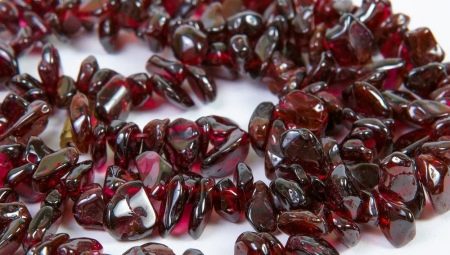
The pomegranate is a semi-precious stone, this gem is very popular and beautiful. The stone got its name from its striking resemblance to pomegranate seeds.
Natural pomegranate, however, can be not only juicy red, but also with tints of copper, orange, rose, greenery. The variety of colors of real stones allows imitations to be used in jewelry. You can distinguish a fake on your own, but for this you need to know the properties of a natural mineral. Due to the high cost, artificial, synthetic pomegranate is becoming very popular. It cannot be called a fake, since it is produced in laboratories using the hydrothermal method of growing from natural stone chips.

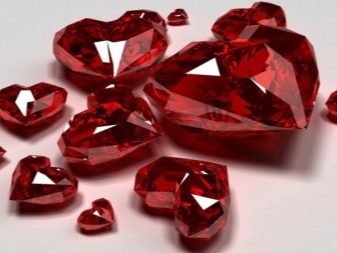
Properties
Garnets do not have the same value as diamonds, emeralds, rubies or sapphires, however, their quality is very high. The mineral stone has the following characteristics:
- durability;
- unpretentious care;
- external showiness.
The stone looks very elegant and noble.
Experts attribute it to stones of the ornamental, semi-precious type.
Its breeds are not numerous and resemble a scattering of pomegranate grains, hence the name. Shades can be varied, varying from crimson-burgundy to orange-copper, red-pink, black, purple, green. It all depends on which component of the natural type is included in the breed. Natural stone has the properties of a crystal mineral. Not all stones are small in size, there are specimens the size of a hen's egg. A real stone can be either transparent-homogeneous or interspersed.

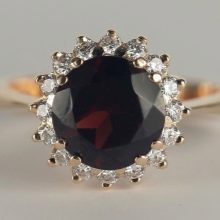
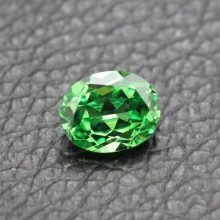
Imitations
Pomegranate became popular several hundred years ago, it was in great demand, and even then dishonest jewelers began to forge the breed.
It is this mineral that is one of the symbols of the Czech state, where the scale of fraud reached unprecedented proportions.
Today in jewelry stores, pomegranate products occupy a large area. However, more than half of the stones are artificial. They imitate pomegranate using cubic zirconia, which are painted in the desired shade. Cubic zirconia itself is an artificial stone created in the Soviet Union.
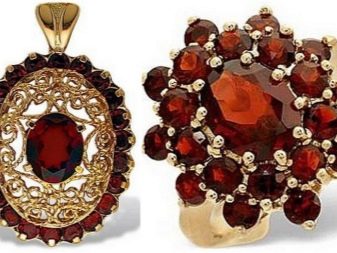

The artificial pomegranate is grown in laboratories and is not fake. The stone is usually forged with glass or plastic counterparts. Fake grenades are most often made from cut glass. There is even a special pomegranate glass, which is used to replace genuine stones in jewelry. In order not to buy a product with banal glass, you need to know exactly the signs of not only natural, but also hydrothermal, artificial pomegranate, which, although grown in laboratories, is still not a fake.
Features of hydrothermal stones
Such stones are grown in specialized laboratories from natural material that remains after the natural mineral has been cut.
The laboratory stone is larger, its purity is obvious, the color is always uniform, uniform, without inclusions.


Stones have almost the same hardness as natural stones, they can be stored without problems. The cut is very high quality, such a gem plays well with colors, if you put it under the light. The artificial specimen has the following characteristic features of crystal growth lines:
- arcuate segments;
- ring-shaped segments;
- straight lines.
Laboratories began to grow pomegranate and sitall in the middle of the 20th century, technologically it is quite difficult, so the price of artificial pomegranate is rather high. In the Soviet Union, jewelry was created with pink, purple, yellow nano-garnets. The production was very widespread.


Garnet or Ruby?
Sometimes the pomegranate itself acts as an imitation - both natural and artificial. They are most often used to replace rubies. However, you do not need to have any special knowledge to distinguish between these two stones:
- the glow of a ruby looks like a diamond;
- a real stone does not magnetize;
- the glow is velvety, very soft, flickering type.

How to determine authenticity?
There are several ways to determine the origin of a gem, as well as to find out if it is a fake. The first is a visual inspection, for which you will need a magnifying device, such as a magnifying glass. It is necessary to analyze the stone in the light and determine such qualities as color, degree of transparency, size.
- Colour. The color of the natural mineral is of a fragmentary type, zones of color, gradation are visible, the richness of the color is different, there may be different tones of the same color. The artificial stone has a uniform, uniform color and color. The nugget contains small inclusions, the hydrothermal garnet does not. If bubbles are present, you have glass in front of you.
- The size. Most often, a natural gem has a size similar to the grains of a pomegranate fruit, after cutting it becomes even smaller. Large stones are most often fake. Particular attention should be paid to green garnets, they are the rarest. If you come across a piece with a large green garnet, it is most likely an imitation. Generally, green grenades can only be bought at auction.
- Shine and shine. Natural stone has a muted shine, its luster is poorly expressed, close to matte. The artificial pomegranate sparkles dazzlingly. Natural garnet transmits light partially, on the edges the beam is refracted, which creates the effect of the play of light.

The second method for determining the authenticity of a mineral is mechanical, here you need a characteristic of the physical properties:
- natural and synthetic specimens are very hard and easily scratch plastic and glass-type surfaces - if you have a fake in front of you, then it will be damaged in the same way as the surface or even more;
- the natural mineral heats up much longer, plastic and glass heats up the fastest;
- a natural gem is magnetised and electrified, you can rub it against a woolen product, for example.


To avoid troubles, it is necessary to purchase jewelry in stores that have all the necessary certificates of conformity. If you are denied documents for a product, it is fake. If you received the product as a gift, inheritance or in another way, you can check it using the above methods. If in doubt, take the stone to a professional jeweler for a full and in-depth assessment.
How to distinguish a ruby from a pomegranate is described below.








